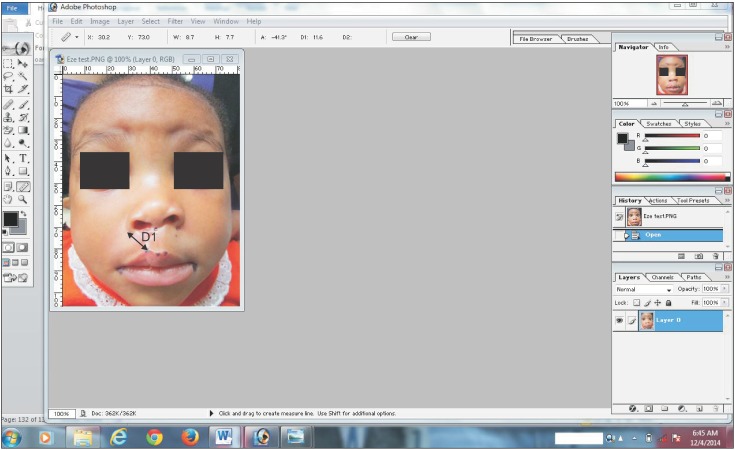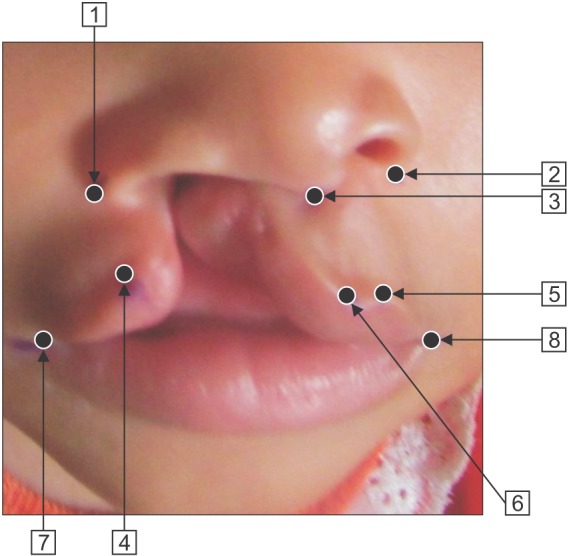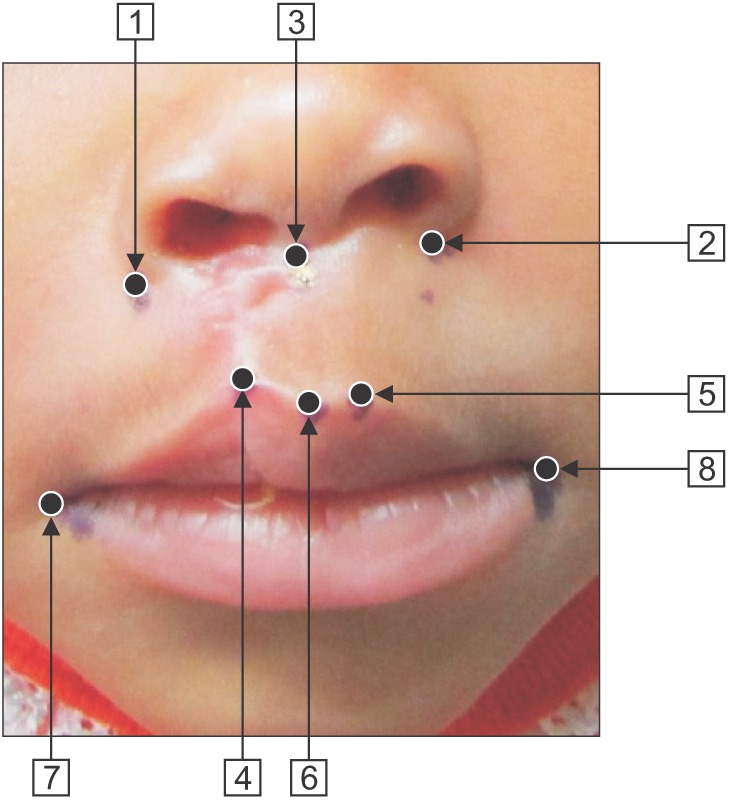J Korean Assoc Oral Maxillofac Surg.
2018 Feb;44(1):3-11. 10.5125/jkaoms.2018.44.1.3.
Unilateral cleft lip repair: a comparison of treatment outcome with two surgical techniques using quantitative (anthropometry) assessment
- Affiliations
-
- 1Department of Surgery, Babcock University, Ilishan-Remo, Nigeria.
- 2Department of Oral and Maxillofacial Surgery, College of Medicine, University of Lagos, Lagos, Nigeria. lanreadeyemo@yahoo.com
- 3Department of Oral Pathology, Radiology, and Medicine, College of Dentistry, University of Iowa, Iowa City, IA, USA.
- KMID: 2405370
- DOI: http://doi.org/10.5125/jkaoms.2018.44.1.3
Abstract
OBJECTIVES
The unilateral cleft lip (UCL) repair technique has evolved extensively over the past century into its modern form and has been identified as an important determinant of treatment outcome. The aim of this study was to evaluate and compare treatment outcomes following repair of UCL using either the Tennison-Randall (triangular) technique or the Millard rotation-advancement technique.
MATERIALS AND METHODS
This was a prospective randomized controlled study conducted at the Lagos University Teaching Hospital between January 2013 and July 2014. A total of 48 subjects with UCL presenting for primary surgery and who satisfied the inclusion criteria were recruited for the study. The subjects were randomly allocated into two surgical groups through balloting. Group A underwent cleft repair with the Tennison-Randall technique, while group B underwent cleft repair with the Millard rotation-advancement technique. Surgical outcome was assessed quantitatively according to anthropometric measurements, using a method described by Cutting and Dayan (2003).
RESULTS
Our 48 enrolled subjects were evenly divided into the two surgery groups (n=24 for both group A and group B). Twenty-seven subjects were male (56.3%) and 21 were female (43.8%), making a sex ratio of 1.3:1. The Millard group showed a greater increase in postoperative horizontal length and vertical lip height and a greater reduction in nasal width and total nasal width. Meanwhile, the Tennison-Randall group showed better reduction of Cupid's-bow width and better philtral height.
CONCLUSION
We did not find any significant differences in the surgical outcomes from the two techniques. The expertise of the surgeon and individual patient preferences are the main factors to consider when selecting the technique for unilateral cleft repair.
Keyword
MeSH Terms
Figure
Cited by 2 articles
-
Importance of various skin sutures in cheiloplasty of cleft lip
Soung Min Kim
J Korean Assoc Oral Maxillofac Surg. 2019;45(6):374-376. doi: 10.5125/jkaoms.2019.45.6.374.Classification of the journal category “oral surgery” in the Scopus and the Science Citation Index Expanded: flaws and suggestions
Seong-Gon Kim
J Korean Assoc Oral Maxillofac Surg. 2019;45(4):186-191. doi: 10.5125/jkaoms.2019.45.4.186.
Reference
-
1. Demke JC, Tatum SA. Analysis and evolution of rotation principles in unilateral cleft lip repair. J Plast Reconstr Aesthet Surg. 2011; 64:313–318. PMID: 20494638.
Article2. Arosarena OA. Cleft lip and palate. Otolaryngol Clin North Am. 2007; 40:27–60. PMID: 17346560.
Article3. Sykes JM. Management of the cleft lip deformity. Facial Plast Surg Clin North Am. 2001; 9:37–50. PMID: 11465005.4. Kirschner RE, LaRossa D. Cleft lip and palate. Otolaryngol Clin North Am. 2000; 33:1191–1215. PMID: 11449783.
Article5. Nwoku AL. Experiences on the surgical repair of unoperated adult cleft patients in Nigeria. Niger Med J. 1976; 4:417–421.6. Millard DR Jr. A radical rotation in single harelip. Am J Surg. 1958; 95:318–322. PMID: 13487963.
Article7. Kim HY, Park J, Chang MC, Song IS, Seo BM. Modified Fisher method for unilateral cleft lip-report of cases. Maxillofac Plast Reconstr Surg. 2017; 39:12. PMID: 28529935.
Article8. Cutting CB, Dayan JH. Lip height and lip width after extended Mohler unilateral cleft lip repair. Plast Reconstr Surg. 2003; 111:17–23. PMID: 12496561.
Article9. van de Ven B, Defrancq J, Defrancq E. Cleft lip surgery: a practical guide. 2nd ed. Zgierz: Drukarna WIST;2008. p. 1–27.10. Asher-McDade C, Roberts C, Shaw WC, Gallager C. Development of a method for rating nasolabial appearance in patients with clefts of the lip and palate. Cleft Palate Craniofac J. 1991; 28:385–390. PMID: 1742308.
Article11. Christofides E. Evaluation of unilateral cleft lip repairs and the evolution of a new technique based on experience and research. J Plast Reconstr Aesthet Surg. 2009; 62:50–55. PMID: 18023632.12. Abdurrazaq TO, Micheal AO, Lanre AW, Olugbenga OM, Akin LL. Surgical outcome and complications following cleft lip and palate repair in a teaching hospital in Nigeria. Afr J Paediatr Surg. 2013; 10:345–357. PMID: 24469486.
Article13. Al-Omari I, Millett DT, Ayoub AF. Methods of assessment of cleft-related facial deformity: a review. Cleft Palate Craniofac J. 2005; 42:145–156. PMID: 15748105.
Article14. Farkas LG, Hajnis K, Posnick JC. Anthropometric and anthroposcopic findings of the nasal and facial region in cleft patients before and after primary lip and palate repair. Cleft Palate Craniofac J. 1993; 30:1–12. PMID: 8418865.
Article15. Sharma VP, Bella H, Cadier MM, Pigott RW, Goodacre TE, Richard BM. Outcomes in facial aesthetics in cleft lip and palate surgery: a systematic review. J Plast Reconstr Aesthet Surg. 2012; 65:1233–1245. PMID: 22591614.
Article16. Tobiasen JM, Hiebert JM. Facial impairment scales for clefts. Plast Reconstr Surg. 1994; 93:31–41. PMID: 8278483.
Article17. Chou PY, Luo CC, Chen PK, Chen YR, Samuel Noordhoff M, Lo LJ. Preoperative lip measurement in patients with complete unilateral cleft lip/palate and its comparison with norms. J Plast Reconstr Aesthet Surg. 2013; 66:513–517. PMID: 23276499.
Article18. Hakim SG, Aschoff HH, Jacobsen HC, Sieg P. Unilateral cleft lip/ nose repair using an equal bows/straight line advancement technique: a preliminary report and postoperative symmetry-based anthropometry. J Craniomaxillofac Surg. 2014; 42:e39–e45. PMID: 23835571.19. Kernahan DA, Stark RB. A new classification for cleft lip and cleft palate. Plast Reconstr Surg Transplant Bull. 1958; 22:435–441. PMID: 13601148.
Article20. Kernahan DA. The striped Y--a symbolic classification for cleft lip and palate. Plast Reconstr Surg. 1971; 47:469–470. PMID: 5574216.
Article21. Campbell A, Costello BJ, Ruiz RL. Cleft lip and palate surgery: an update of clinical outcomes for primary repair. Oral Maxillofac Surg Clin North Am. 2010; 22:43–58. PMID: 20159477.
Article22. Kumar V, Abbas AK, Fausto N. Robbins and Cotran pathologic basis of disease. 7th ed. Philadelphia: Elsevier Saunders;2005. p. 113–117.23. Clark RA. Wound repair. In : Clark RAF, editor. The molecular and cellular biology of wound repair. New York: Plenum Press;1996. p. 3–50.24. Amaratunga NA. Combining Millard's and Cronin's methods of unilateral cleft lip repair — a comparative study. Asian J Oral Maxillofac Surg. 2004; 16:5–9.25. Hurwitz DJ, Ashby ER, Llull R, Pasqual J, Tabor C, Garrison L, et al. Computer-assisted anthropometry for outcome assessment of cleft lip. Plast Reconstr Surg. 1999; 103:1608–1623. PMID: 10323693.
Article26. Millard DR. Cleft craft: the evolution of its surgery: the unilateral deformity Vol. 1. Boston: Little Brown;1976. p. 15–40.27. Bilwatsch S, Kramer M, Haeusler G, Schuster M, Wurm J, Vairaktaris E, et al. Nasolabial symmetry following Tennison-Randall lip repair: a three-dimensional approach in 10-year-old patients with unilateral clefts of lip, alveolus and palate. J Craniomaxillofac Surg. 2006; 34:253–262. PMID: 16777429.
Article28. Xing H, Bing S, Kamdar M, Yang L, Qian Z, Sheng L, et al. Changes in lip 1 year after modified Millard repair. Int J Oral Maxillofac Surg. 2008; 37:117–122. PMID: 18023144.
Article29. Chowdri NA, Darzi MA, Ashraf MM. A comparative study of surgical results with rotation-advancement and triangular flap techniques in unilateral cleft lip. Br J Plast Surg. 1990; 43:551–556. PMID: 2224350.
Article30. Sameh E, Amr S, Ashraf E. Evaluation of primary unilateral cleft lip repair: a proposed scoring system. Egypt J Surg. 2009; 28:4–7.
- Full Text Links
- Actions
-
Cited
- CITED
-
- Close
- Share
- Similar articles
-
- A comprehensive review of surgical techniques in unilateral cleft lip repair
- Surgical outcomes of 14 consecutive bilateral cleft lip patients treated with a modified version of the Millard and Manchester methods
- Repair of Complete Cleft Lip Using Extended Mohler Repair
- Unilateral cleft lip: evaluation and comparison of treatment outcome with two surgical techniques based on qualitative (subject/guardian and professional) assessment
- A Comparative Study of Cronin Triangular Flap and Rotation-Advancement Repair in Unilateral Complete Cleft Lip




